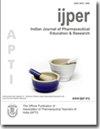Central Composite Design Assisted Formulation Development and Optimization of Gastroretentive Floating Tablets of Dextromethorphan Hydrobromide
IF 0.8
4区 医学
Q3 EDUCATION, SCIENTIFIC DISCIPLINES
Indian Journal of Pharmaceutical Education and Research
Pub Date : 2023-10-04
DOI:10.5530/ijper.57.4.120
引用次数: 0
Abstract
Abstract: Objectives: The existing study is concerned with the formulation and optimization of dextromethorphan hydrobromide floating tablets via central composite design. Materials and Methods: Direct compression method was employed to prepare the tablets. Drug -excipient studies were executed through FT-IR and DSC analysis. The independent variables selected were the concentrations of Carbopol 934 (X1 ) and HPMC K15M (X2 ). The dependent variables designated were Floating Lag Time (FLT) and Drug Release (DR) at 12 hr. The model was found to be nonlinear and the curvature effect was significant. Hence, the system suggested to central composite design. Results: FT-IR studies demonstrated that there is no considerable interaction amid the drug and the excipients. DSC studies revealed that drug and excipient were compatible as there is no significant alteration in melting point of drug when blended with excipients. The precompression parameters of the formulations showed good flow properties. The evaluation of post compression parameters indicated that all the prepared formulations were within the specified limits. Floating lag time of formulations were marked to be less than 1 min and total floating time exceeding 12 hr. Percentage drug release of all formulations were in the range of 89.7% to 99.4%. The obtained design space/contour plots were used for selecting batches in desirable ranges. Conclusion: The results revealed that experimental design was successfully used to optimize polymer concentrations. It was determined that the central composite design would be used to formulate dextromethorphan gastroretentive floating tablets with fewer trials and higher quality features. Keywords: Dextromethorphan Hydrobromide, Carbopol, HPMC, Central Composite design, Floating lag time.中心复合设计辅助盐酸右美沙芬胃保留浮片的处方开发与优化
摘要:目的:通过中心设计对氢溴酸右美沙芬漂浮片的处方进行优化。材料与方法:采用直接压缩法制备。通过FT-IR和DSC分析进行药物赋形剂研究。选取的自变量为卡波波尔934 (X1)和HPMC K15M (X2)浓度。指定的因变量为漂浮滞后时间(FLT)和12小时药物释放量(DR)。模型是非线性的,曲率效应显著。因此,系统建议采用中心复合设计。结果:红外光谱研究表明,药物与辅料之间没有明显的相互作用。DSC研究表明,药物和辅料是相容的,当药物与辅料混合时,药物的熔点没有明显的变化。配方的预压缩参数表现出良好的流动性能。后压缩参数评价表明,所制备的制剂均在规定的限度内。配方的浮滞时间小于1 min,总浮滞时间大于12 hr。各制剂的释药率在89.7% ~ 99.4%之间。获得的设计空间/轮廓图用于在理想范围内选择批次。结论:实验设计可有效地优化聚合物的浓度。本研究确定采用中心复合设计可制备试验较少、质量特征较高的右美沙芬胃保留浮片。关键词:氢溴酸右美沙芬,卡波波尔,HPMC,中心复合设计,漂浮滞后时间
本文章由计算机程序翻译,如有差异,请以英文原文为准。
求助全文
约1分钟内获得全文
求助全文
来源期刊
CiteScore
1.40
自引率
0.00%
发文量
227
审稿时长
>12 weeks
期刊介绍:
The official journal of Association of Pharmaceutical Teachers of India (APTI) and is being published since 1967. IJPER, a quarterly publication devoted to publish reviews and research articles in pharmacy and the related disciplines of Pharmaceutical education. It mainly covers the articles of special interest, covering the areas of Pharmaceutical research, teaching and learning, laboratory innovations, education technology, curriculum design, examination reforms, training and other related issues. It encourages debates and discussions on the issues of vital importance to Pharmaceutical education and research. The goal of the journal is to provide the quality publications and publish most important research and review articles in the field of drug development and pharmaceutical education. It is circulated and referred by more than 6000 teachers, 40,000 students and over 1000 professionals working in Pharmaceutical industries, Regulatory departments, hospitals etc.

 求助内容:
求助内容: 应助结果提醒方式:
应助结果提醒方式:


